key TOYOTA COROLLA 2009 10.G Owners Manual
[x] Cancel search | Manufacturer: TOYOTA, Model Year: 2009, Model line: COROLLA, Model: TOYOTA COROLLA 2009 10.GPages: 468, PDF Size: 9.31 MB
Page 2 of 468
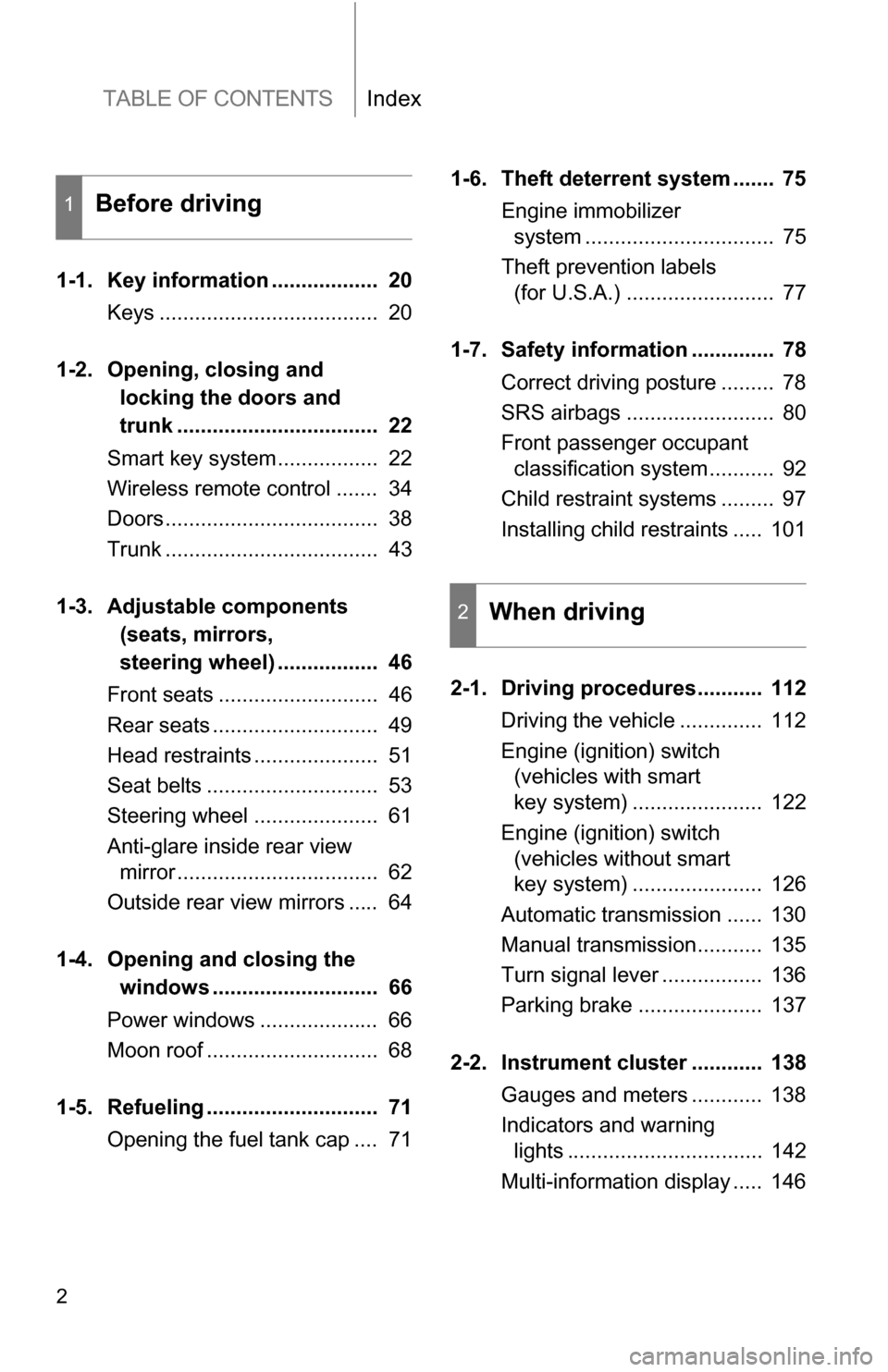
TABLE OF CONTENTSIndex
2
1-1. Key information .................. 20Keys ..................................... 20
1-2. Opening, closing and
locking the doors and
trunk .................................. 22
Smart key system................. 22
Wireless remote control ....... 34
Doors.................................... 38
Trunk .................................... 43
1-3. Adjustable components
(seats, mirrors,
steering wheel) ................. 46
Front seats ........................... 46
Rear seats ............................ 49
Head restraints ..................... 51
Seat belts ............................. 53
Steering wheel ..................... 61
Anti-glare inside rear view mirror .................................. 62
Outside rear view mirrors ..... 64
1-4. Opening a nd closing the
window s ............................ 66
Power windows .................... 66
Moon roof ............................. 68
1-5. Refueling ............................. 71 Opening the fuel tank cap .... 71 1-6. Theft deterrent system ....... 75
Engine immobilizer system ................................ 75
Theft prevention labels (for U.S.A.) ......................... 77
1-7. Safety information .............. 78 Correct driving posture ......... 78
SRS airbags ......................... 80
Front passenger occupant classification system ........... 92
Child restraint systems ......... 97
Installing child restraints ..... 101
2-1. Driving procedures........... 112 Driving the vehicle .............. 112
Engine (ignition) switch (vehicles with smart
key system) ...................... 122
Engine (ignition) switch (vehicles without smart
key system) ...................... 126
Automatic transmission ...... 130
Manual transmission........... 135
Turn signal lever ................. 136
Parking brake ..................... 137
2-2. Instrument cluster ............ 138 Gauges and meters ............ 138
Indicators and warning lights ................................. 142
Multi-information display ..... 146
1Before driving
2When driving
Page 4 of 468
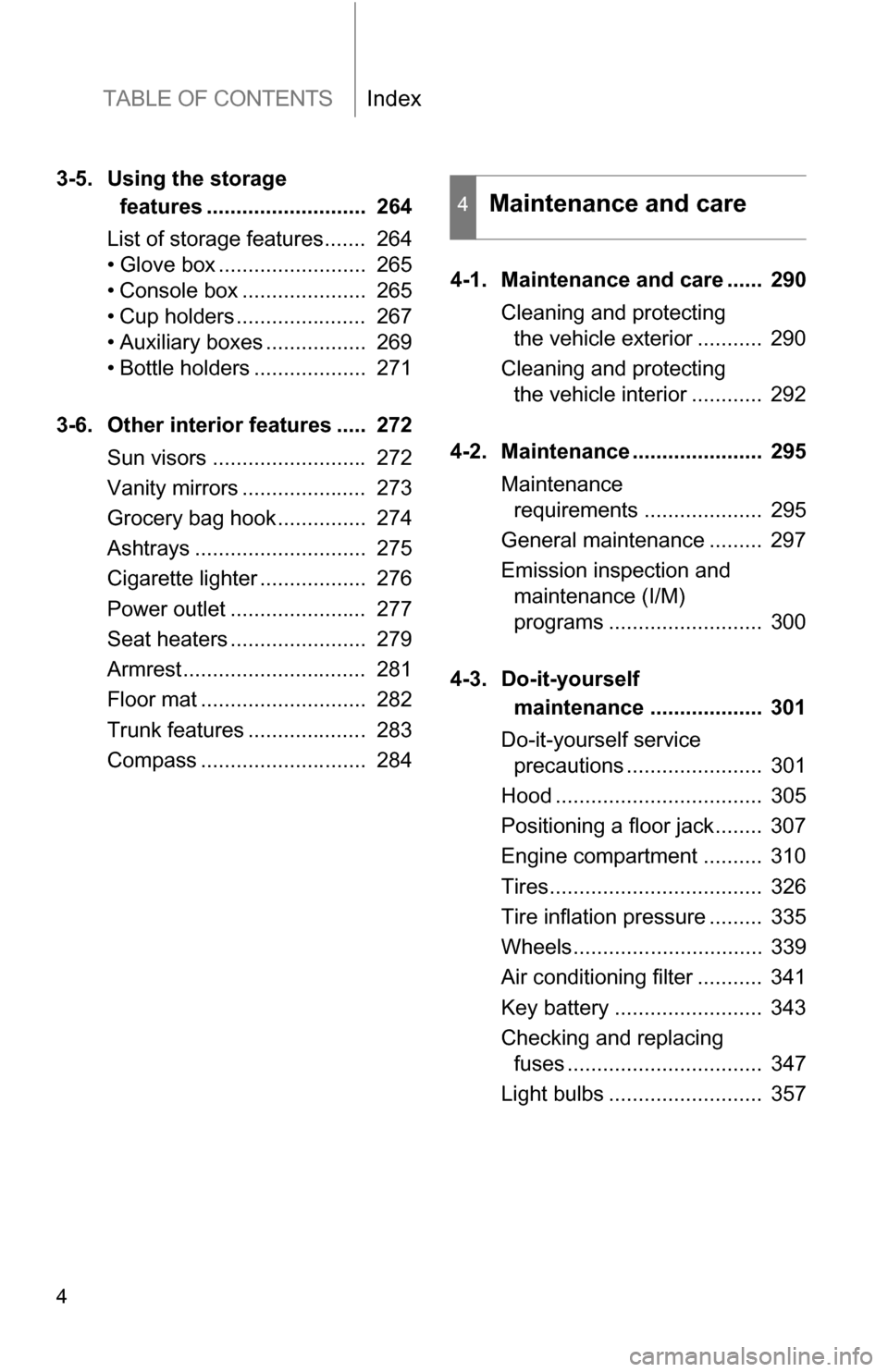
TABLE OF CONTENTSIndex
4
3-5. Using the storage features ........................... 264
List of storage features....... 264
• Glove box ......................... 265
• Console box ..................... 265
• Cup holders ...................... 267
• Auxiliary boxes ................. 269
• Bottle holders ................... 271
3-6. Other interior features ..... 272 Sun visors .......................... 272
Vanity mirrors ..................... 273
Grocery bag hook............... 274
Ashtrays ............................. 275
Cigarette lighter .................. 276
Power outlet ....................... 277
Seat heaters ....................... 279
Armrest............................... 281
Floor mat ............................ 282
Trunk features .................... 283
Compass ............................ 284 4-1. Maintenance and care ...... 290
Cleaning and protecting the vehicle exterior ........... 290
Cleaning and protecting the vehicle interior ............ 292
4-2. Maintenance ...................... 295 Maintenance requirements .................... 295
General maintenance ......... 297
Emission inspection and maintenance (I/M)
programs .......................... 300
4-3. Do-it-yourself maintenance ................... 301
Do-it-yourself service precautions ....................... 301
Hood ................................... 305
Positioning a floor jack........ 307
Engine compartment .......... 310
Tires.................................... 326
Tire inflation pressure ......... 335
Wheels................................ 339
Air conditioning filter ........... 341
Key battery ......................... 343
Checking and replacing fuses ................................. 347
Light bulbs .......................... 357
4Maintenance and care
Page 5 of 468
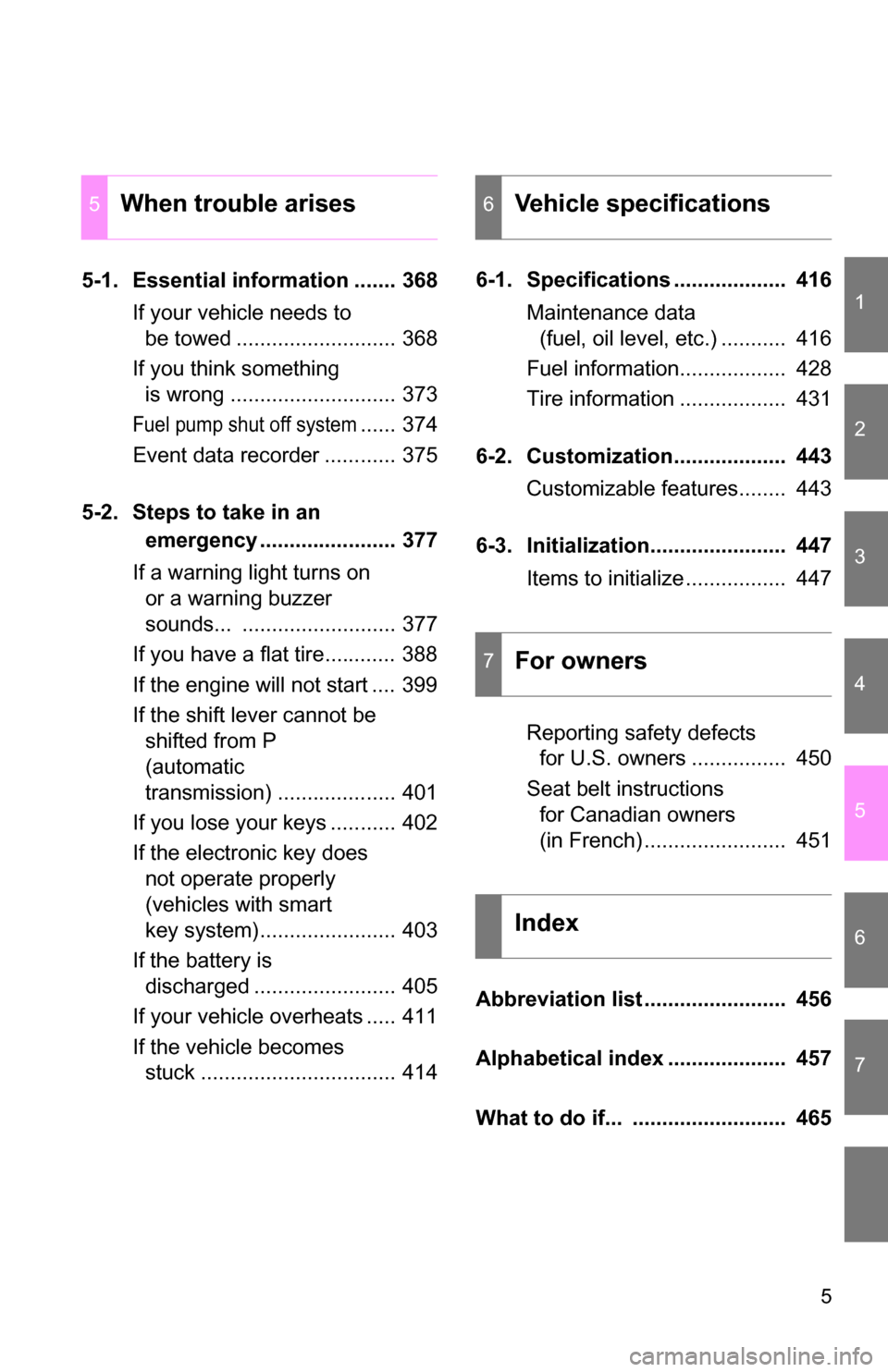
1
2
3
4
5
6
7
5
5-1. Essential information ....... 368If your vehicle needs to be towed ........................... 368
If you think something is wrong ............................ 373
Fuel pump shut off system...... 374
Event data recorder ............ 375
5-2. Steps to take in an emergency ....................... 377
If a warning light turns on or a warning buzzer
sounds... .......................... 377
If you have a flat tire............ 388
If the engine will not start .... 399
If the shift lever cannot be shifted from P
(automatic
transmission) .................... 401
If you lose your keys ........... 402
If the electronic key does not operate properly
(vehicles with smart
key system)....................... 403
If the battery is discharged ........................ 405
If your vehicle overheats ..... 411
If the vehicle becomes stuck ................................. 414 6-1. Specifications ................... 416
Maintenance data (fuel, oil level, etc.) ........... 416
Fuel information.................. 428
Tire information .................. 431
6-2. Customization................... 443 Customizable features........ 443
6-3. Initialization....................... 447 Items to initialize ................. 447
Reporting safety defects for U.S. owners ................ 450
Seat belt instructions for Canadian owners
(in French) ........................ 451
Abbreviation list ........................ 456
Alphabetical index .................... 457
What to do if... .......................... 465
5When trouble arises6Vehicle specifications
7For owners
Index
Page 13 of 468
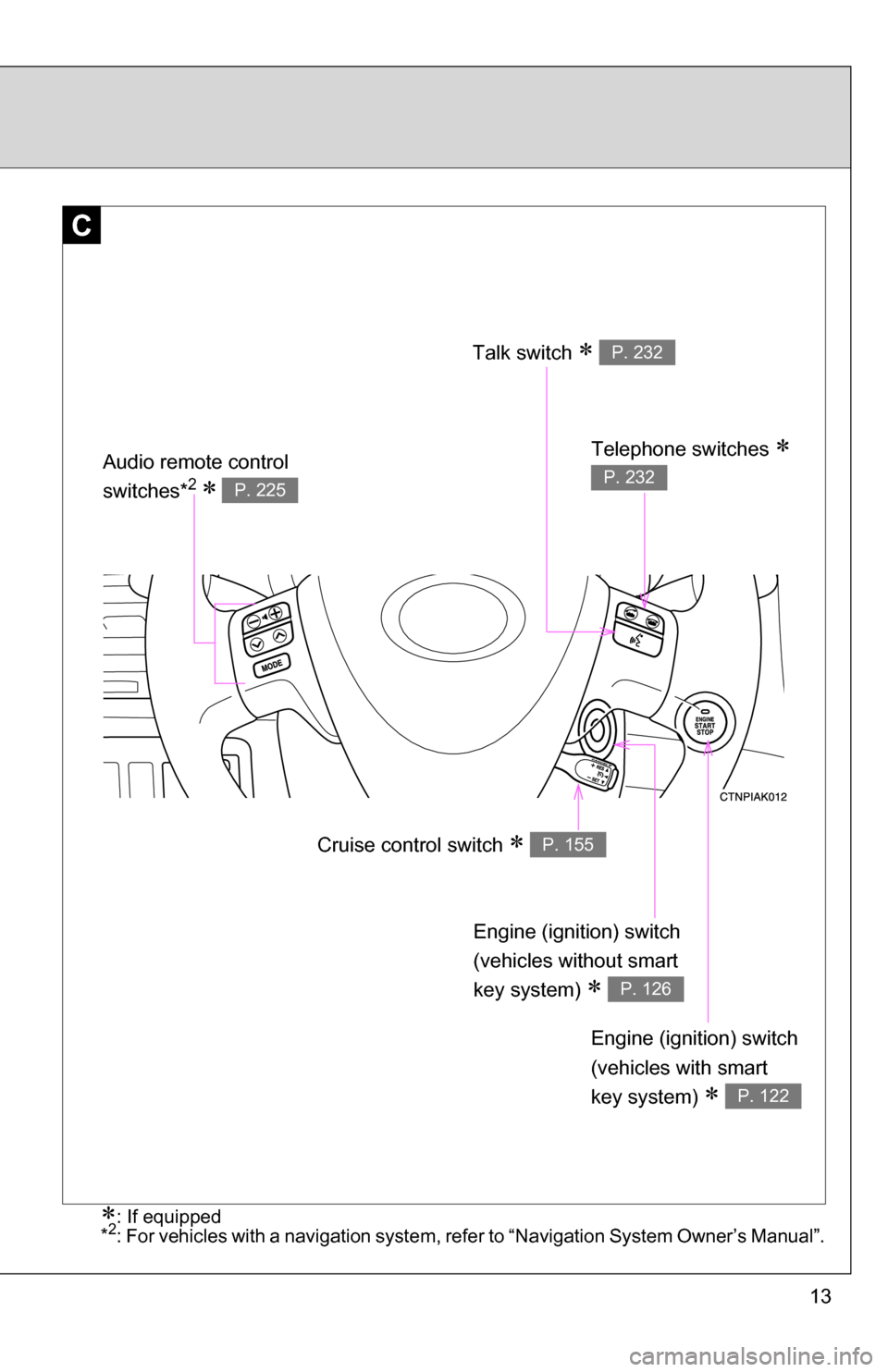
13
C
Cruise control switch P. 155
Talk switch P. 232
Engine (ignition) switch
(vehicles without smart
key system)
P. 126
Engine (ignition) switch
(vehicles with smart
key system)
P. 122
Audio remote control
switches*2 P. 225
Telephone switches
P. 232
: If equipped
*2: For vehicles with a navigation system, refer to “Navigation System Owner’s Manual”.
Page 16 of 468
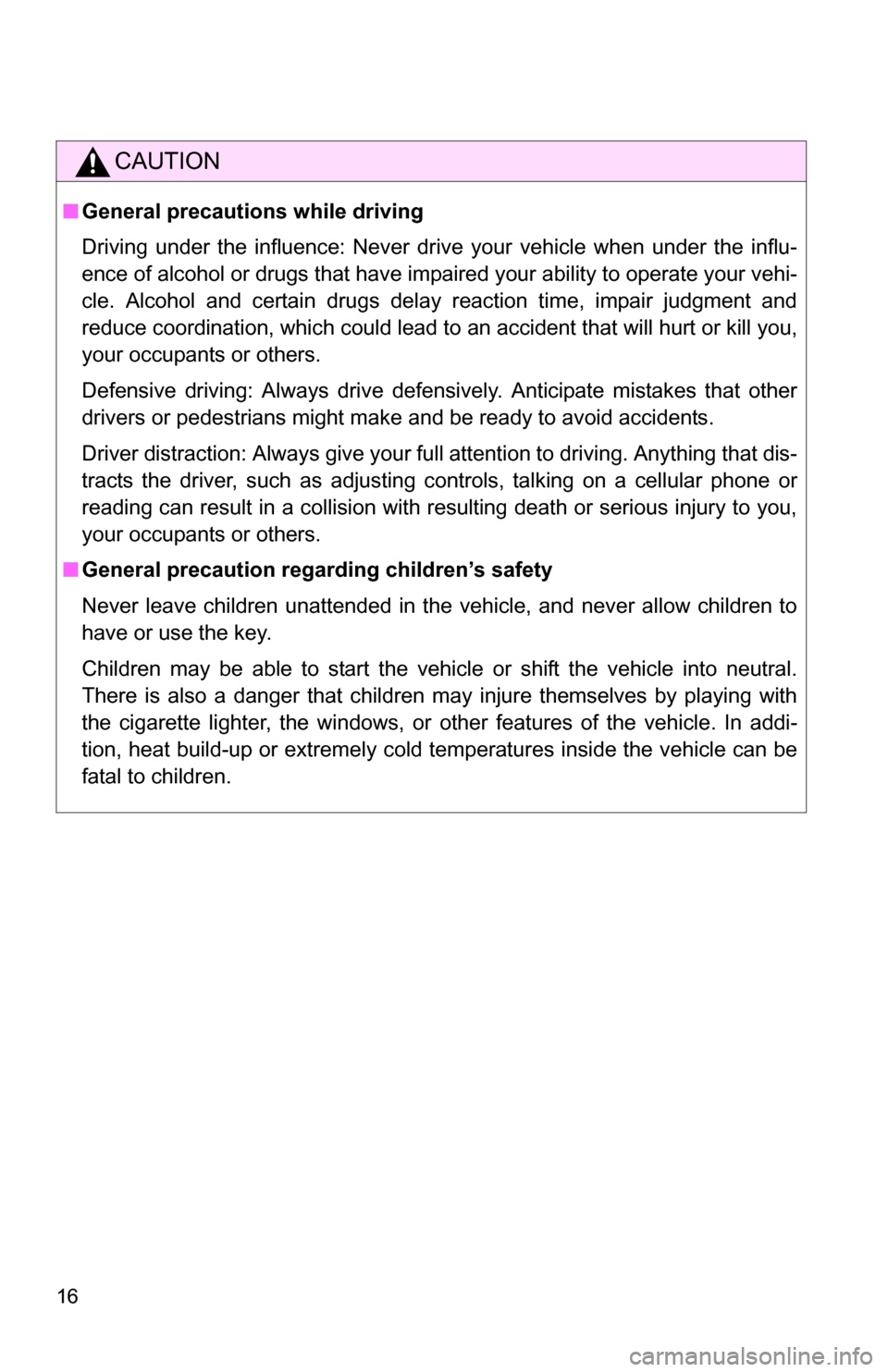
16
CAUTION
■General precautions while driving
Driving under the influence: Never drive your vehicle when under the influ-
ence of alcohol or drugs that have impaired your ability to operate your vehi-
cle. Alcohol and certain drugs delay reaction time, impair judgment and
reduce coordination, which could lead to an accident that will hurt or kill you,
your occupants or others.
Defensive driving: Always drive defensively. Anticipate mistakes that other
drivers or pedestrians might make and be ready to avoid accidents.
Driver distraction: Always give your full attention to driving. Anything that dis-
tracts the driver, such as adjusting controls, talking on a cellular phone or
reading can result in a collision with resulting death or serious injury to you,
your occupants or others.
■ General precaution regarding children’s safety
Never leave children unattended in the vehicle, and never allow children to
have or use the key.
Children may be able to start the vehicle or shift the vehicle into neutral.
There is also a danger that children may injure themselves by playing with
the cigarette lighter, the windows, or other features of the vehicle. In addi-
tion, heat build-up or extremely cold temperatures inside the vehicle can be
fatal to children.
Page 19 of 468
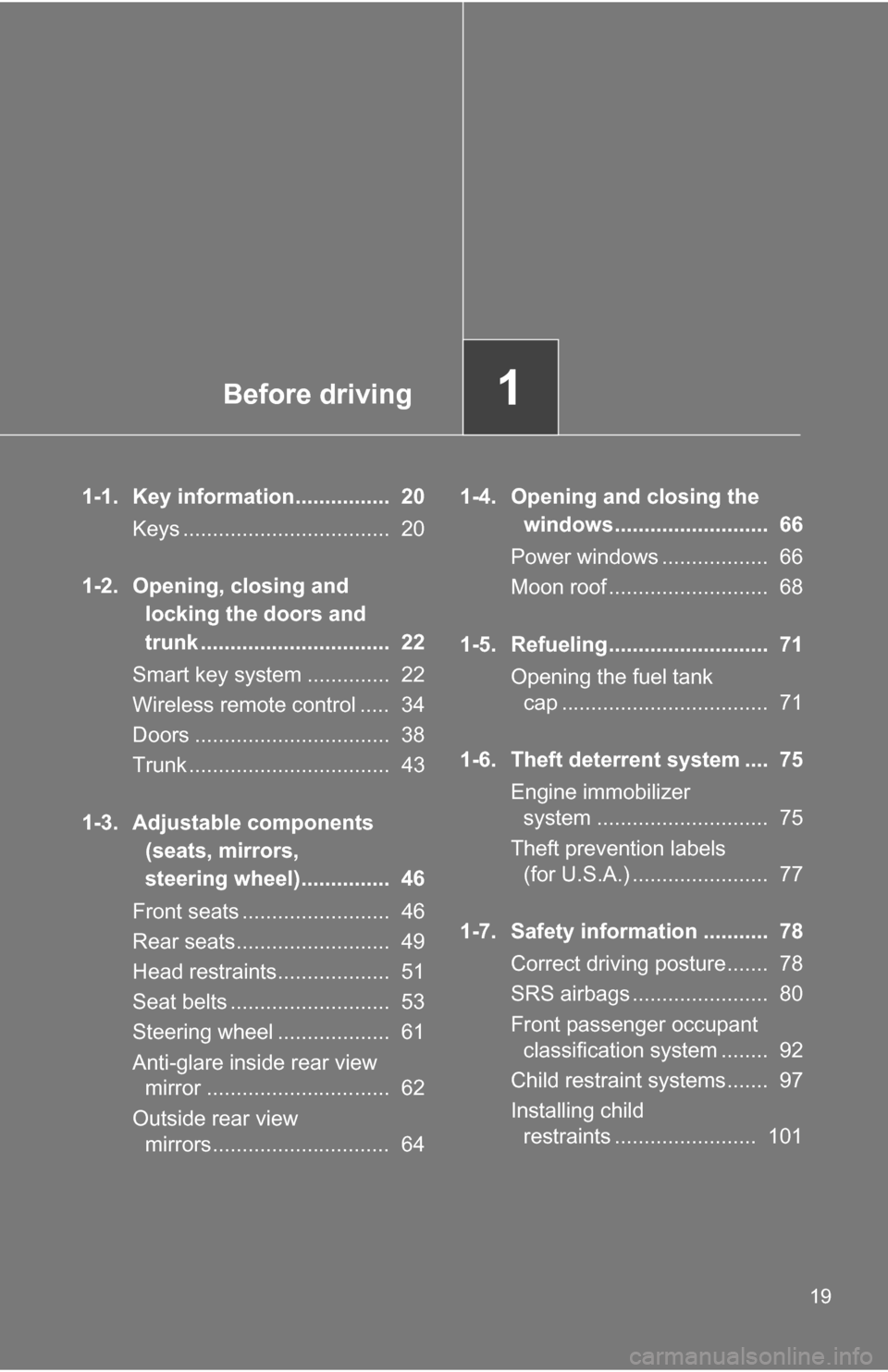
Before driving1
19
1-1. Key information................ 20Keys ................................... 20
1-2. Opening, closing and locking the doors and
trunk ................................ 22
Smart key system .............. 22
Wireless remote control ..... 34
Doors ................................. 38
Trunk .................................. 43
1-3. Adjustable components (seats, mirrors,
steering wheel)............... 46
Front seats ......................... 46
Rear seats.......................... 49
Head restraints................... 51
Seat belts ........................... 53
Steering wheel ................... 61
Anti-glare inside rear view mirror ............................... 62
Outside rear view mirrors.............................. 64 1-4. Opening and closing the
windows.......................... 66
Power windows .................. 66
Moon roof ........................... 68
1-5. Refueling........................... 71 Opening the fuel tank cap ................................... 71
1-6. Theft deterrent system .... 75 Engine immobilizer system ............................. 75
Theft prevention labels (for U.S.A.) ....................... 77
1-7. Safety information ........... 78 Correct driving posture....... 78
SRS airbags ....................... 80
Front passenger occupant classification system ........ 92
Child restraint systems....... 97
Installing child restraints ........................ 101
Page 20 of 468
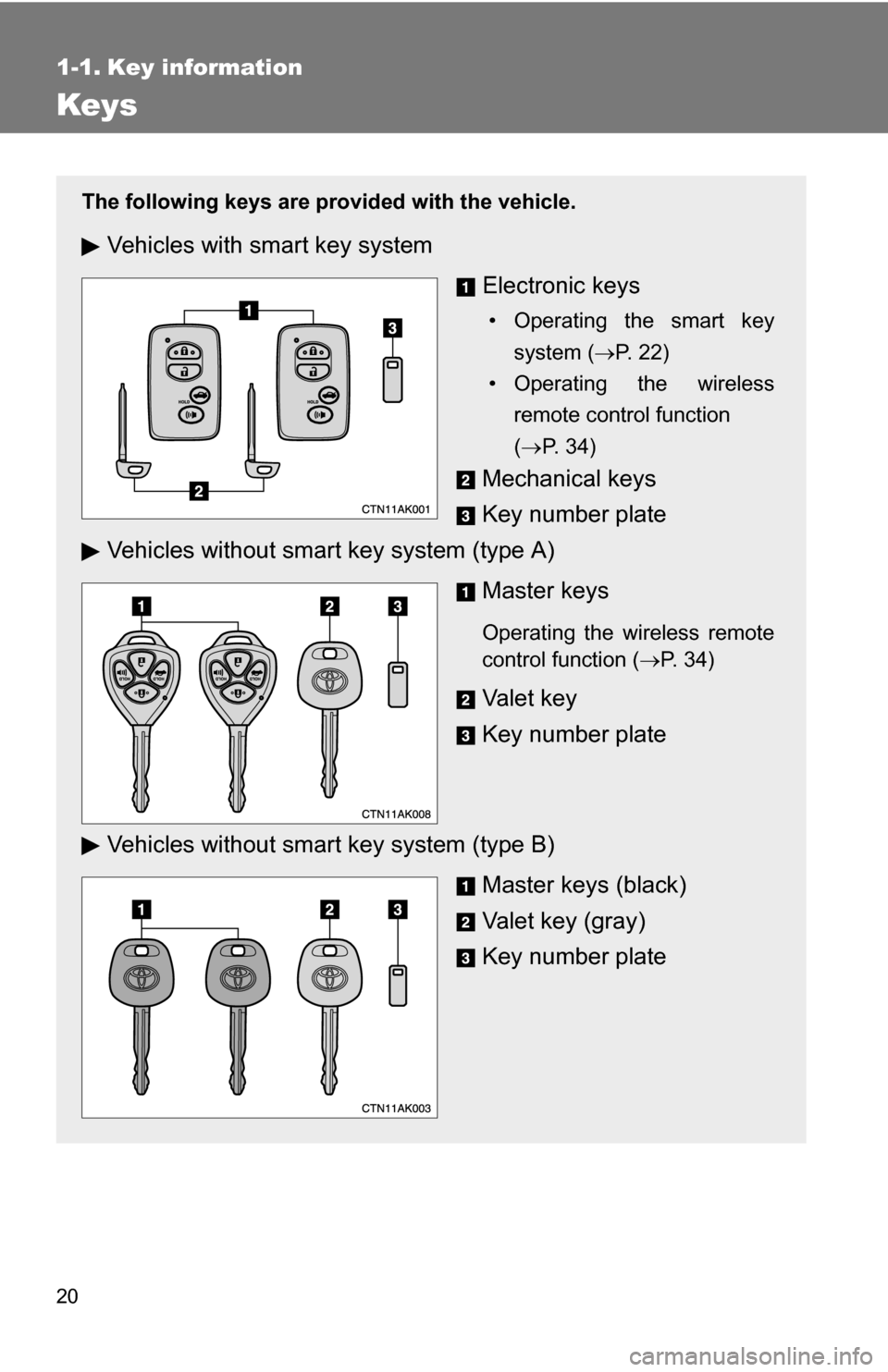
20
1-1. Key information
Keys
The following keys are provided with the vehicle.
Vehicles with smart key system
Electronic keys
• Operating the smart keysystem ( P. 22)
• Operating the wireless remote control function
( P. 34)
Mechanical keys
Key number plate
Vehicles without smar t key system (type A)
Master keys
Operating the wireless remote
control function ( P. 34)
Va l e t k e y
Key number plate
Vehicles without smar t key system (type B)
Master keys (black)
Valet key (gray)
Key number plate
Page 21 of 468
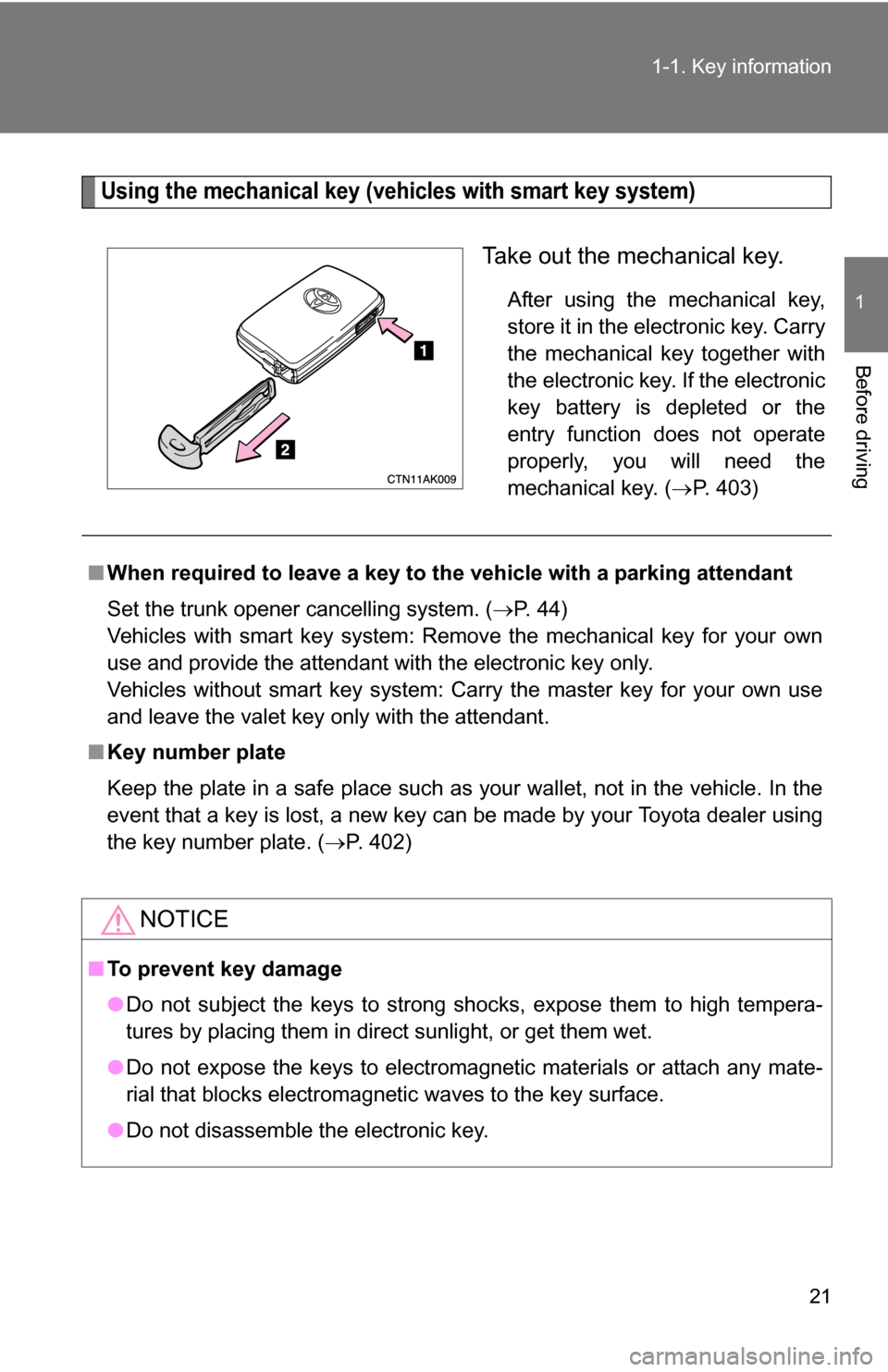
21
1-1. Key information
1
Before driving
Using the mechanical key (vehicles with smart key system)
Take out the mechanical key.
After using the mechanical key,
store it in the electronic key. Carry
the mechanical key together with
the electronic key. If the electronic
key battery is depleted or the
entry function does not operate
properly, you will need the
mechanical key. (
P. 403)
■When required to leave a key to th e vehicle with a parking attendant
Set the trunk opener cancelling system. ( P. 44)
Vehicles with smart key system: Remove the mechanical key for your own
use and provide the attendant with the electronic key only.
Vehicles without smart key system: Carry the master key for your own use
and leave the valet key only with the attendant.
■ Key number plate
Keep the plate in a safe place such as your wallet, not in the vehicle. In the
event that a key is lost, a new key can be made by your Toyota dealer using
the key number plate. ( P. 402)
NOTICE
■To prevent key damage
●Do not subject the keys to strong shocks, expose them to high tempera-
tures by placing them in direct sunlight, or get them wet.
● Do not expose the keys to electromagnetic materials or attach any mate-
rial that blocks electromagnetic waves to the key surface.
● Do not disassemble the electronic key.
Page 22 of 468
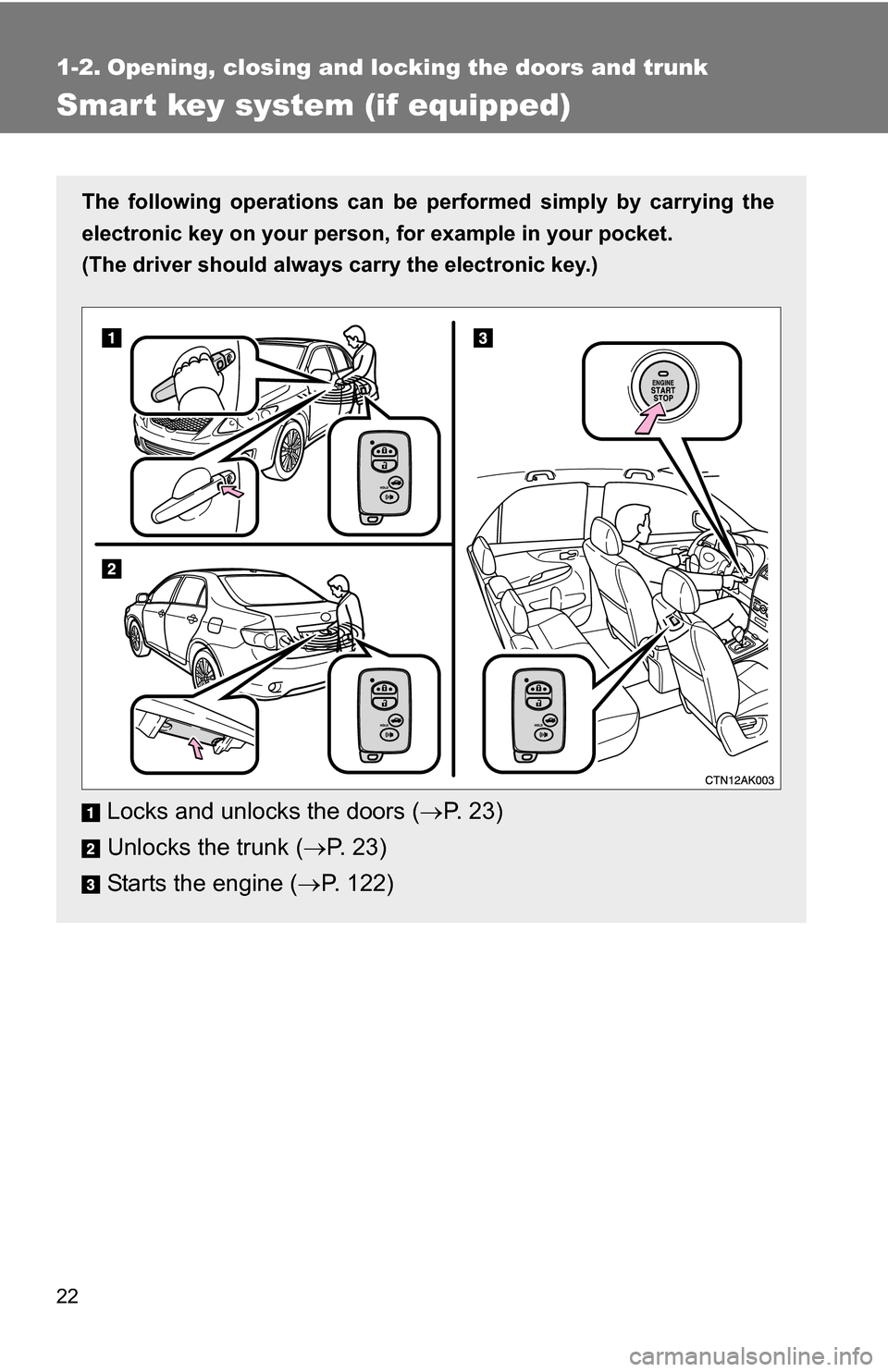
22
1-2. Opening, closing and locking the doors and trunk
Smart key system (if equipped)
The following operations can be performed simply by carrying the
electronic key on your person, for example in your pocket.
(The driver should always carry the electronic key.)
Locks and unlocks the doors ( P. 2 3 )
Unlocks the trunk ( P. 2 3 )
Starts the engine ( P. 122)
Page 25 of 468
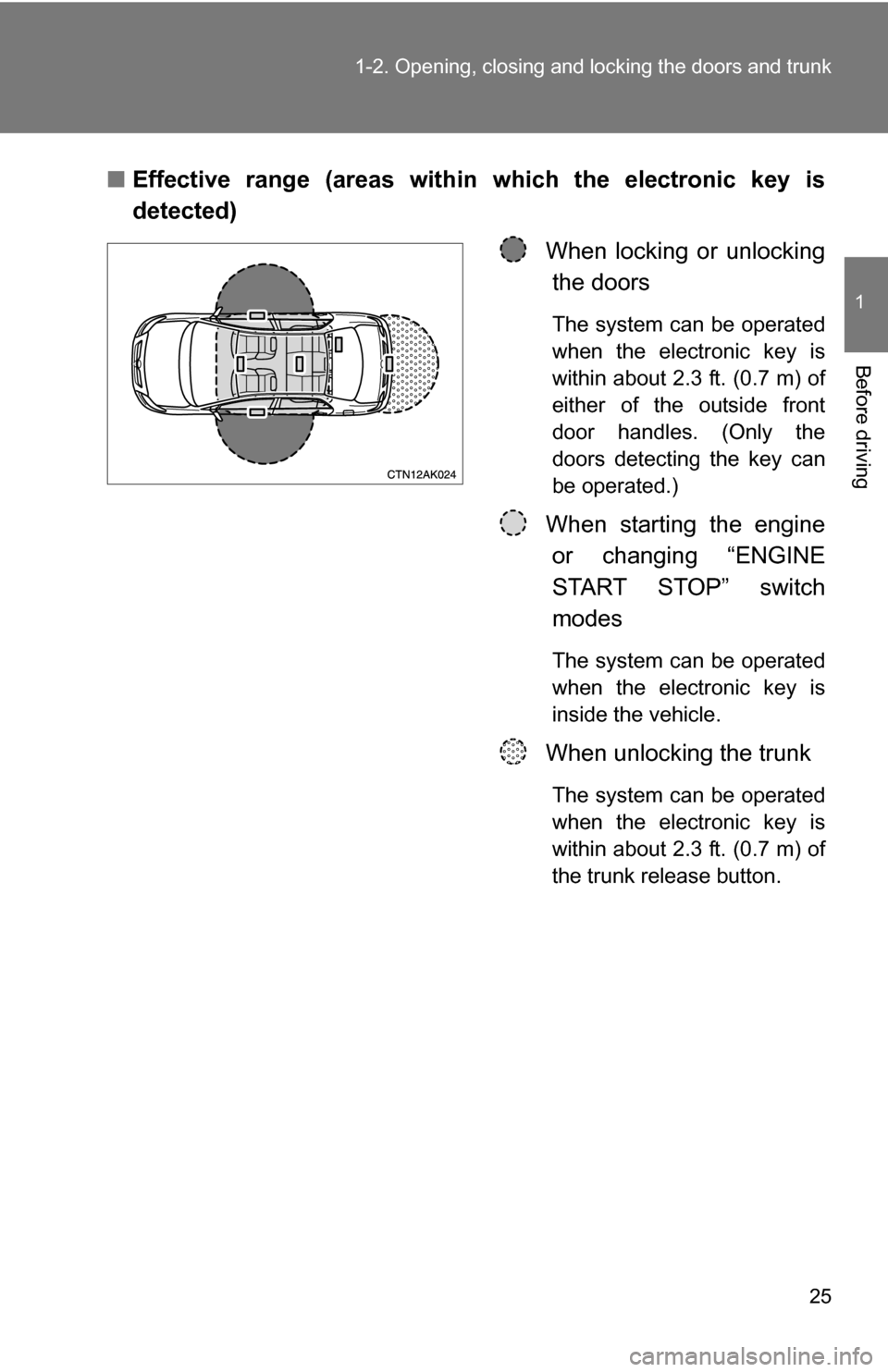
25
1-2. Opening, closing and locking the doors and trunk
1
Before driving
■
Effective range (areas within which the electronic key is
detected)
When locking or unlockingthe doors
The system can be operated
when the electronic key is
within about 2.3 ft. (0.7 m) of
either of the outside front
door handles. (Only the
doors detecting the key can
be operated.)
When starting the engineor changing “ENGINE
START STOP” switch
modes
The system can be operated
when the electronic key is
inside the vehicle.
When unlocking the trunk
The system can be operated
when the electronic key is
within about 2.3 ft. (0.7 m) of
the trunk release button.